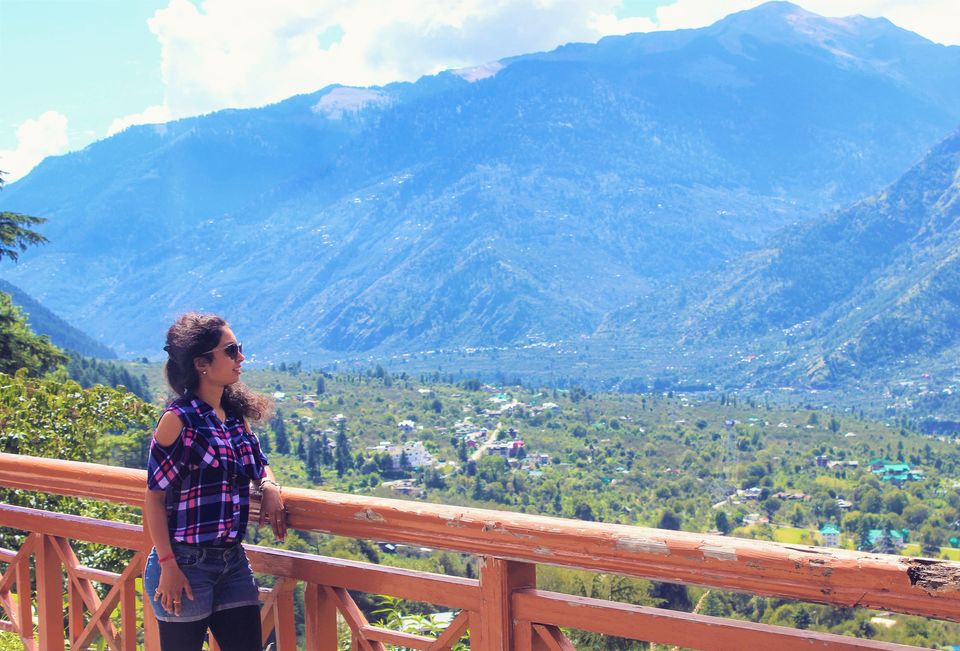
The quieter side of Kullu, perched on a wooded slope bedecked with a smattering of beautiful temples and a castle, Naggar should be your next weekend getaway from Delhi.
Located on the left bank of river Beas at an altitude of 1,800 meters (5,775 ft.), facing the great Himalayan range, Naggar is 22 km from the snow station Manali, Himachal Pradesh.

This is a place for solitude and soliloquy, poetry and art and days spent rambling through forests, glades, orchards and cute little villages which excel in traditional Himachali hospitality.
Naggar is ensconced high up in the mountains and has some of the best views to offer. Naggar was once the capital of the kingdom of Kullu in 17th century under Raja Jagat Singh. Naggar Castle, the official seat of kings for centuries, was built by Raja Sidh Singh more than 500 years ago. Now the Naggar castle is converted into a hotel.

How to Reach: Naggar is well connected by road, Naggar is 22 km south of Manali. You can hire a taxi service to cover the distance from Manali to Naggar.
Naggar is 301 km from Chandighar and 539 km from New Delhi. You can also take direct bus of HRTC from Chandighar or New Delhi.
Nearest airport to Naggar is Bhuntar, which is 26 km from Naggar, you can hire a taxi or take HRTC or a private bus to Naggar.

It's all up to you how you want to travel, and what medium you choose to reach Naggar from Manali a bus or a taxi. That same implies on us, but as we are a little crazy so we decided to hire an auto rickshaw form Manali to Naggar. Ya I agree that's sounds stupid and bit uncomfortable and slow too. But sometimes it's good to go for something crazy because at in the end "the memories you made in the mountains" that's all really matters.




High on the east side of the Kullu Valley, sleepy Naggar was once capital of the Kullu kingdom and is perhaps the most charming village in the Kullu valley. Unlike rest of the Kullu valley’s major town located by river Beas, Naggar is ensconced high up in the mountains and has some best views to offer like Naggar Castle, the Roerich Museum and other stone and wooden Temples. Russian painter and explorer Nicholas Roerich liked it so much he settled here in the early 20th century. It's an easy day trip from Manali, but with interesting sights and fine walks including the Chandrakani Pass trek to Malana in the Parvati Valley, and some good guesthouses and restaurants, it's a fine place for a few days' Peaceful and relaxing stay. You should explore Naggar on foot there’s no better way. There are several chai shops (Tea shop) where you could rest your feet and guzzle tea or apple juice, the signature drink of Himachal.




Castle is actually something of a misnomer. For one, it has been converted into an HPTDC hotel. This medieval Castle was built by Raja Sidh Singh of Kullu kingdom around 1460 A.D. Now it was taken over to Himachal Pradesh Tourism Development Corporation (HPTDC), to run as a heritage hotel, since 1978. The castle overlooks the Kullu Valley and apart from the spectacular view and superb location this has a flavor of authentic western Himalayan architecture. Naggar Castle, now converted into a hotel since 1978 is an imposing structure. It was built by using a local stone. The style of construction ensured a lot of resilience in the structure, and it successfully withstood the mighty and disastrous earthquake of 1905. The tale recounted by villagers of its construction is interesting. It is said that the stone for building the edifice was to be brought from the other side of river Naggar. So right up to Baragarh fort, a human chain of laborers stood, passing the stones from hand to hand. The stones, picked up from the ruins of Gardhak, a fortified palace of Rana Bhosal, gave the king his castle. The site commands a stupendous view of the valley and the snow-laden peaks.









The Gauri Shankar Temple is located near Naggar Bus Stand. The temple of Gauri Shankar is situated below the Naggar Castle. Dedicated to Lord Shiva, this 12th-century Hindu temple features a domed top & intricate carvings. The temple is believed to be the last monument of the Gurjara-Pratihara traditions. The temple is famous for its splendid Shikhara Style architecture. The temple features a dome shaped top while the base is present in square shape. Gauri Shankar Temple is dedicated to Lord Shiva and famous for stone carvings. The idols of Gauri and Shankar are set up on the pedestal, seated over Nandi. The Garbagriha is decorated with beautiful carvings of images of Lord Ganesh, various people playing different musical instruments and also with the carvings of dancing girls. The temple is surrounded by lush and abundant greenery overlooking the Beas River. Gauri Shankar temple is facing the valley side where one can see the ice covered peaks of Kullu valley.
About 2 km above the bus stand of Naggar, the house of a Russian artist Nikolai Roerich. It’s also the house that Hindi cinema’s original oomph girl, Devika Rani. After she married to Nicholas Roerich son, Svetoslav in 1945 she lived here later she converted this house into an art center. Which much later became the Roerich Museum. Roerich Art Gallery is set in the middle of well-tended gardens of Naggar. Nicholas Roerich was a Russian artist who settled down in these beautiful hills of Himalayas. Roerich was a gifted painter, who dream of unifying the world through art. The gallery has the perfect setting for the display of art featuring his paintings that capture the essence and beauty of Himalayas. The gallery is created in the then residence Nicholas Roerich and is maintained by Government formed trust. The museum houses mythological characters of the Himalayas in deep and bright colors. There are also few photographs of the painter including the one with Jawahar Lal Nehru (First Prime Minister of India).



Nicholas Roerich: 'Master of the Mountains: Nicholas had been drawn to India and the Himalayas since the time he was a child. A magnificent picture of the snow covered Himalayan mountain peak, Kanchenjunga hung in the living room of his family estate Isvara, near St. Petersburg.
Roerich had studied eastern philosophies extensively, which was a direct influence of his wife Helena, particularly Buddhism, Hinduism, and the Teaching of Agni Yoga. The influence of India is seen in some of his works, even before he visited the country. Roerich was drawn to the majestic snow capped Himalayas. He felt the answer to his quest in both his art and spiritual journey was to be found in these forbidding realms. In - (1928, Roerich founded the 'Urusvati' Himalayan Research Institute and shifted base from Darjeeling to Kullu (Himachal Pradesh, India) . In Sanskrit, 'Urusvati' means-'Star of the Morning'.

Nourished and inspired by the solemn and ethereal beauty that lay in the purity of the Himalayas, he created thousands of paintings dedicated to their magnificence, to the ancient wisdom of Indian Rishis, and to various spiritual Masters. To the Indian people of his time he was known also as a talented writer of books and of countless essays which appeared in such well-known journals as The Educational Review; The Modem Review; Prabuddha Bharata; The Scholar and Vedanta Kesari. The constant theme of his articles was the human spirit on its long path of spiritual aspiration towards enlightenment and inner transformation.
From his early years Roerich had switched from oil to tempera and pastels, whose bright pure colors characterize his subsequent works. Roerich's mastery of colors is evident in the use of a brilliant yet subtle palette. Mountain ranges in various shades of blue disappearing into the swirling white clouds, vivid mauve skies forming a backdrop to pastel pink and red brown hues. steel grey mountains framed by a glow of yellow sky at dusk, and still waters of mountain lakes reflecting an emerald green luminescence all heighten the magical moods of Roerich's Himalayan landscapes. In Roerich's opinion, the beauty of nature is an eternal source that elevates and ennobles the human soul. The mountains in his works always symbolize spiritual 'ascent. Approach to harmony, light and eternity.





The International Roerich Memorial Trust (IRMT) was founded in 1992-93. The Government of India and the Government of Himachal Pradesh to preserve and promote the heritage of the outstanding Russian family of the Roerichs and develop the holy Roerich Estate into a world-class museum, educational, scientific and cultural center.


This fascinating memorial and museum complex 1 km above the Naggar castle focuses on the former home of Russian painter and explorer Nicholas Roerich and his wife Elena Roerich. They settled here in 1928 and stayed until his death in 1947. The house's lower floor displays some of Nicholas' landscape paintings many depicting Himalayan mountains and paintings by the couple's son Svetoslav Reorich, while the upper floor preserves some of the private rooms you can only look in through the windows. In the scenic hillside gardens are Nicholas' samadhi (tomb) and an exhibit on Svetoslav Reorich and his wife, the Indian film star Devika Rani.





Jagatsukh was the former capital of Manali and presently is the biggest village in Kullu district. Its main claim to famous for it’s Gaurishankar Temple, which is dedicated to the Hindu god Shiva. Jagatsukh can be easily reached by taxi from Manali. Approximate driving distance between Jagatsukh and Manali is 7 kms or 4.3 Miles. Jagatsukh, which is well known for its old temples, houses a Shikhara style built Shiva temple, also known as Jagatsukh Shiva Temple. This temple is surrounded by picturesque valleys and lofty snow-clad mountains that look even striking during the winters. Other than being a Hindu pilgrimage site, this place is a perfect honeymoon destination and a lot of tourists visit this spot to enjoy the wholesome beauty of the place.




This beautiful temple enshrining a Shiva-Linga comprise of square gharbhagriha and a small portico. It is atypical in the design of its vedibandha, jangha, sikhara and doorways well as its portico columns. The temple triratha on plan is crown with a sikhara topped by an amalaka. The side wall of the garbdagriha contain on the Bhadras a relief niche enshrining the figures of Vishnu on the south Surya on the east and Brahma on the north. The corner walls are composed of square pilasters embellished with Ghatapallava motifs both at the base and the capitals. The roof of the portico is supported by two fluted columns. The Sukanasa, above contains the Bhadramukha below which is carved Lakulisa in padmasana with folded hands. The dooroamb has three sahas decorated with patra-motifs. The figure of Ganesha is on the lalatabimba. The temple is dated to eighth-ninth century AD. In view of its artistic and archaeological importance, the temple is declared protected as a monument of national importance.





A mountaintop Shikhara-style temple featuring an intimate shrine & a chalet-shaped roof. Gayatri Temple at Jagatsukh in Himachal Pradesh an ancient temple with intricate woodwork with modern marble image of Goddess Gayatri. This temple of Goddess Sri Gayathri is built by Sri Chidambara Dixit with the support of many Devotees. The inspiration to build a temple came from his divine blessing from the Goddess Gayathri Devi. This temple was built in 1962 by the divine grace of Goddess Gayathri. In 1977 the idol of Lord Anjaneya was installed inside the temple complex. Lots of tourists visit this temple to enjoy the wholesome beauty of the region.










